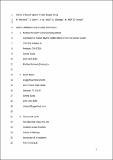Clicks of dwarf sperm whales (Kogia sima)
Abstract
The two species of the genus Kogia are widely distributed throughout the world's temperate and tropical oceans, but because they are small and highly cryptic, they are difficult to monitor. The acoustic signals of K. breviceps have been described previously, but the signals of K. sima have remained unknown. Here we present three recordings of K. sima, two from free-ranging animals and one from a captive setting, representing both the Atlantic Ocean and Pacific Ocean. The acoustic signals of K. sima are very similar to the signals of K. breviceps and other species that have narrow-band, high-frequency (NBHF) clicks. Free-ranging K. sima produce “usual” clicks that have mean peak and centroid frequencies of 127–129 kHz, mean −3 dB bandwidth of 10 kHz, mean −10 dB bandwidth of 16–17 kHz, and mean interclick interval of 110–164 ms. Although K. sima clicks cannot yet be distinguished from those of K. breviceps or other NBHF clicking species, our detailed description of this species' signals reveals the similarities between the two Kogia species, and thus allows for passive acoustic monitoring of the genus Kogia in regions where other NBHF species are not present.
Citation
Merkens , K , Mann , D , Janik , V M , Claridge , D , Hill , M & Oleson , E 2018 , ' Clicks of dwarf sperm whales ( Kogia sima ) ' , Marine Mammal Science , vol. 34 , no. 4 , pp. 963-978 . https://doi.org/10.1111/mms.12488
Publication
Marine Mammal Science
Status
Peer reviewed
ISSN
0824-0469Type
Journal article
Description
Captive acoustic recordings were approved by the Institutional Animal Care and Use Committee of the University of South Florida. Research in The Bahamas was conducted under the Department of Fisheries research permit 12A and was supported by a Royal Society University Research Fellowship to VMJ. Recordings in Guam were made under NMFS permit 15240 and were supported with funding provided by the NOAA/NMFS Pacific Islands Fisheries Science Center, and the U.S. Navy Pacific Fleet.Collections
Items in the St Andrews Research Repository are protected by copyright, with all rights reserved, unless otherwise indicated.

